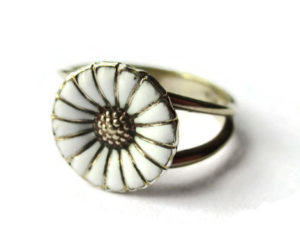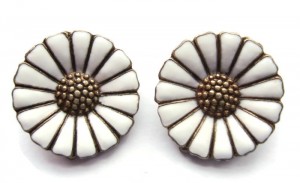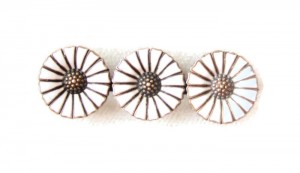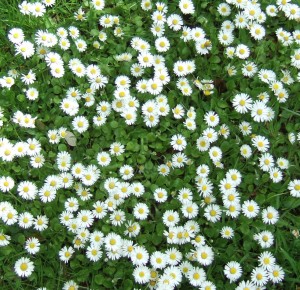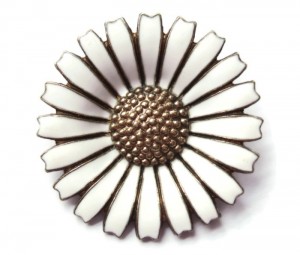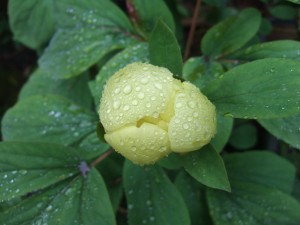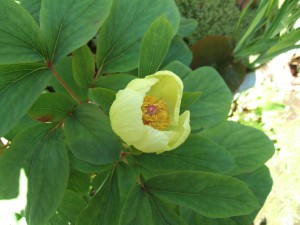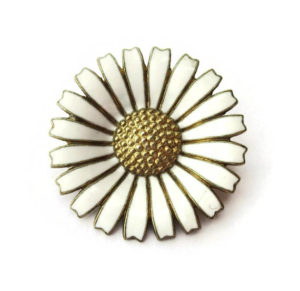
Enamel daisy brooch by the Royal Jeweller to the Danish court, Anton Michelsen. For sale in my Etsy shop: click on photo for details. (NOW SOLD).
On 16 April 1940, Princess Margrethe of Denmark was born. She was born in troubled times. A mere seven days before her birth, her country had been invaded by Nazi Germany.
To celebrate the Princess’s birth, jewellers in Denmark produced daisy jewellery: ‘marguerit’ is the Danish for daisy, so this made a nice play on her name. Daisy jewellery was produced in various forms, including brooches, pendants, bracelets, earrings and necklaces, all in gold-washed sterling silver and white enamel. It became immediately popular, not just as a mark of respect for the monarchy but also, and perhaps more importantly, as a symbol of national resistance against the Nazis. To wear a piece of daisy jewellery was to give a tacit ‘up yours’ to the occupying forces.
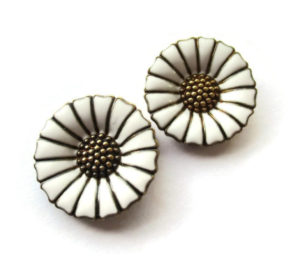
Anton Michelsen daisy clip on earrings For sale in my Etsy shop: click on photo for details. (NOW SOLD).
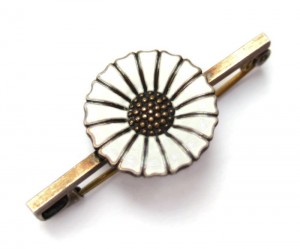
Anton Michelsen daisy bar brooch, rare, for sale at Inglenookery on Etsy. Perhaps one of the prettiest possible forms of passive resistance? (NOW SOLD).
The daisy jewellery was initially made by several firms of silversmiths in Denmark, with that of Anton Michelsen (1809-1877) being the most famous. The firm that bore Michelsen’s name was founded in 1841 and by 1848 Michelsen had become the Jeweller to the Royal Danish Court. The firm was based in Copenhagen. Other firms making daisy jewellery in the wartime period included Viggo Pedersen and Bernhard Hertz. Those making them shortly after the war included Hans Hansen and Aarre & Krogh Eftf.
The earliest daisy brooches fasten with a ‘C’ catch or a safety pin-type catch (rollover catches were used on the later brooches). The first pieces of jewellery were produced for domestic consumption only so were generally marked just with ‘925 S’ (referring to the silver purity of 925 parts per 1000, ie sterling silver), whereas the later ones also had ‘DENMARK’ and/or ‘STERLING’, indicating they were intended for the international as well as the domestic market.
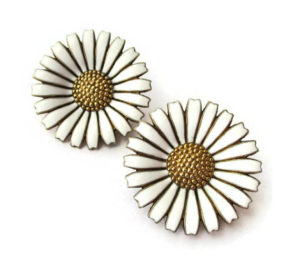
Large daisy clipon earrings by Anton Michelsen. For sale in my Etsy shop: click on photo for details. (NOW SOLD).
Daisy jewellery was so popular and struck such a chord with Danes that it was made through the postwar period and continues to be made to this day. The famous silversmith company of Georg Jensen later took over the firm of A. Michelsen, and continued to make daisy jewellery. Recently they have produced jewellery based on the earliest Michelsen designs.
Although Denmark does not have an official floral emblem, in 1980 the daisy won an unofficial competition and was voted the ‘unofficial official’ flower of Denmark, no doubt in part because of the fondness the Danes have towards this flower and all it represents.
And little Princess Margrethe, who was born as Nazi tanks rolled across her country? She ascended the Danish throne in 1972 and as Queen Margrethe II, still rules today as the sovereign of Denmark.
So to wear or own an item of Danish daisy jewellery is to possess not only a beautiful piece of personal adornment, but also a moving little piece of history.
